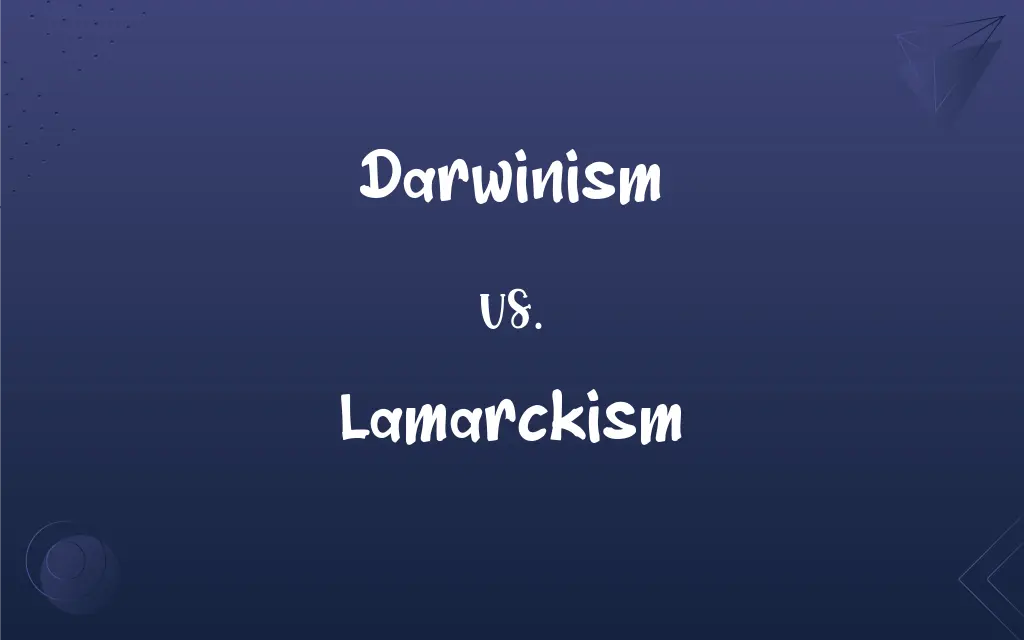Darwinism vs. Lamarckism: What's the Difference?
Edited by Janet White || By Harlon Moss || Updated on October 28, 2023
Darwinism posits natural selection as evolution's driver, while Lamarckism suggests acquired traits during an organism's lifetime are inheritable.

Key Differences
Darwinism, developed by Charles Darwin, emphasizes that evolution occurs due to natural selection, where the fittest organisms survive to reproduce. Lamarckism, on the other hand, proposed by Jean-Baptiste Lamarck, focuses on the idea that an organism can change during its lifetime in response to its environment, and these changes are passed onto its offspring.
Central to Darwinism is the concept of variation, where genetic mutations that are advantageous allow an organism to have a better chance at survival and reproduction. Lamarckism operates on the principle that characteristics which are used more become stronger and more pronounced, while those that are not used fade away.
Darwinism is supported by extensive modern genetic evidence, making it the prevailing theory today. Lamarckism, while largely discredited in the light of modern genetics, introduced the idea that an organism's environment can influence its evolutionary progress.
Darwinism proposes that environmental pressures act on the variation that already exists within a population. In contrast, Lamarckism suggests that the environment directly shapes traits, which are then passed down.
While Darwinism is largely accepted in the scientific community due to its grounding in genetic evidence, Lamarckism's ideas, specifically the inheritance of acquired traits, lack empirical support. However, both theories have played pivotal roles in shaping our understanding of evolution.
ADVERTISEMENT
Comparison Chart
Proponent
Charles Darwin
Jean-Baptiste Lamarck
Main Mechanism
Natural selection
Use and disuse, inheritance of acquired traits
Genetic Support
Supported by modern genetics
Largely discredited in modern genetics
Response to Environment
Environmental pressures act on existing variations
Environment directly shapes traits
Current Scientific Standing
Accepted theory in modern biology
Mostly obsolete, but introduced environment's role in evolution
ADVERTISEMENT
Darwinism and Lamarckism Definitions
Darwinism
Darwinism posits that advantageous genetic mutations increase survival odds.
Through Darwinism, it's understood that beneficial traits become more common over generations.
Lamarckism
Lamarckism is the theory that organisms can acquire traits during their lifetime and pass them on.
Lamarckism was initially accepted before genetics disproved some of its main concepts.
Darwinism
Darwinism suggests evolution occurs gradually over time.
Darwinism proposes that small changes accumulate to produce new species.
Lamarckism
Lamarckism introduced the idea of environmental influence on evolution.
Despite its flaws, Lamarckism helped pave the way for further evolutionary thought.
Darwinism
Darwinism is the evolutionary theory emphasizing natural selection.
Darwinism has greatly influenced modern biology's understanding of species adaptation.
Lamarckism
Lamarckism emphasizes the role of use and disuse in shaping traits.
Lamarckism suggests that if a giraffe stretches its neck, its offspring will have longer necks.
Darwinism
Darwinism focuses on variations within a population influencing evolution.
Darwinism explains why certain animals thrive in specific environments due to beneficial traits.
Lamarckism
Lamarckism largely lacks empirical genetic support.
Modern genetics has shown that traits acquired during one's lifetime, as proposed by Lamarckism, aren't typically inherited.
Darwinism
Darwinism operates on the principle of "survival of the fittest."
Darwinism argues that only the best-adapted organisms pass their genes to the next generation.
Lamarckism
Lamarckism asserts that environment directly influences organismal traits.
In Lamarckism, a blacksmith's muscular arm, acquired from work, would be passed to his offspring.
Darwinism
A theory of biological evolution developed by Charles Darwin and others, stating that all species of organisms have developed from other species, primarily through natural selection. Also called Darwinian theory.
Lamarckism
A theory of biological evolution holding that the changes occurring in an organism through use and disuse of its body parts in response to environmental change are inherited by its offspring.
Lamarckism
The theory that structural variations, characteristic of species and genera, are produced in animals and plants by the direct influence of physical environments, and esp., in the case of animals, by effort, or by use or disuse of certain organs. It is a discredited theory, not believed by modern biologists.
Lamarckism
A theory of organic evolution claiming that acquired characteristics are transmitted to offspring
FAQs
Who proposed Darwinism?
Charles Darwin.
What is the core concept behind Darwinism?
Darwinism emphasizes evolution through natural selection based on variations within populations.
Who is the mind behind Lamarckism?
Jean-Baptiste Lamarck.
Is Darwinism supported by modern genetic research?
Yes, Darwinism is supported and widely accepted in modern genetics.
How would Lamarckism explain a giraffe's long neck?
Lamarckism would suggest giraffes stretched their necks to reach high foliage, and this acquired trait was passed to their offspring.
What is the primary mechanism of Lamarckism?
Lamarckism suggests acquired traits during an organism's lifetime can be inherited by offspring.
How does Lamarckism perceive the influence of environment on traits?
Lamarckism posits that organisms directly adapt to their environments, passing those acquired traits to offspring.
How does Darwinism explain the existence of diverse traits within a species?
Darwinism suggests diverse traits arise from genetic mutations, with beneficial ones becoming more prevalent via natural selection.
Can Darwinism and Lamarckism coexist in modern biological thought?
While Darwinism dominates, certain concepts, especially regarding epigenetics, have revived limited aspects of Lamarckism.
Does Darwinism involve the inheritance of acquired traits?
No, Darwinism focuses on genetic variations and their selection over generations.
What's the main difference between Darwinism and Lamarckism?
Darwinism focuses on natural selection, while Lamarckism centers on the inheritance of acquired traits.
Which theory is more accepted in the scientific community today?
Darwinism is widely accepted, while Lamarckism's main ideas are mostly rejected.
Does Lamarckism hold any relevance in today's biological discussions?
While its main concepts are discredited, discussions about epigenetics sometimes revisit aspects of Lamarckism.
How does Lamarckism stand in the light of current scientific understanding?
Lamarckism is largely discredited in modern genetics, though it historically influenced evolutionary thought.
Does Darwinism explain rapid evolutionary changes?
Darwinism traditionally focuses on gradual changes, but punctuated equilibrium theory addresses faster evolutionary events.
Did Lamarckism predate Darwinism?
Yes, Jean-Baptiste Lamarck proposed his ideas before Charles Darwin's theory of natural selection.
Is the "use and disuse" principle associated with Darwinism?
No, it's a key principle of Lamarckism, not Darwinism.
Are the ideas of Lamarckism completely obsolete?
While its main mechanisms are outdated, it historically paved the way for evolutionary thought by emphasizing environmental influences.
How does Darwinism explain the role of environment in evolution?
In Darwinism, environmental pressures act on the existing genetic variations within populations.
Has Lamarckism made any significant contributions to evolutionary theory?
Yes, it introduced the idea that the environment can influence evolutionary changes, though its mechanisms are mostly discredited.
About Author
Written by
Harlon MossHarlon is a seasoned quality moderator and accomplished content writer for Difference Wiki. An alumnus of the prestigious University of California, he earned his degree in Computer Science. Leveraging his academic background, Harlon brings a meticulous and informed perspective to his work, ensuring content accuracy and excellence.
Edited by
Janet WhiteJanet White has been an esteemed writer and blogger for Difference Wiki. Holding a Master's degree in Science and Medical Journalism from the prestigious Boston University, she has consistently demonstrated her expertise and passion for her field. When she's not immersed in her work, Janet relishes her time exercising, delving into a good book, and cherishing moments with friends and family.































































